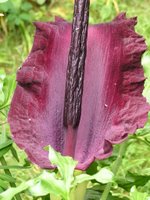
There are some plants, which fall into the "Love 'em or Hate 'em" catagory, here is just such a plant. Friends, meet Dracunculus Vulgaris, the "Dragon Arum". Most gardeners would probably see this as a novelty plant, something unusual to show their friends. For Aroid lovers like me however, it's really something special, in more ways than one. It is native to the Mediterranean, growing in Crete, Greece and Southern Turkey amongst other places. Its most notable features are its size, they grow to 5ft. and when in flower, the smell. This can last from 24 to 48 hours depending on how long it takes for flies to pollinate it and it's yuk! It reminds me of rotting flesh. Don't let this put you off because its well worth growing for the foliage alone and you can always cut off the spathe before it opens. The picture shows the spathe on one of my plants, it measured 18 ins. in length the day before it opened.
Cultivation is easy. A well drained spot in full sun or very light shade is best. Dig out an area of soil about 6 to 9 inches deep. Fork over the bottom of the hole to loosen the soil up. Other than some bonemeal, I don't put anything beneath the corm. Place the corm in the bottom of the hole and replace the soil. Other than adding more bonemeal and a dash of well rotted manure to the topsoil I don't do anything else. Water and fertilize well when in growth, but otherwise leave it alone. As noted above, these can grow tall, so they might need staking in windy conditions. In my garden, they tend to show themselves around about the end of March and once the weather warms up a bit they're off. Other than flies on the spathe doing their stuff, I've never seen any pests on my plants and slugs seem to give them a wide berth. Can't say I blame 'em. One final point, good drainage is most important as any standing water will cause them to rot.
I lift the corms when the plant has died down completely. Allthough offsets can be grown on in deep pots, using a well drained mix of J.I. no 2 and gravel, I prefer to plant them out in the garden. I dig out a small area about 6 ins. deep, loosen the soil in the bottom and place the corms about 4 ins. apart. I replace the top soil and leave them alone. Put in a marker so you remember where they are. When the first growth appears I begin watering and I give heavy feeds of high nitrogen fertilizer to bulk up the corms. After a couple or three years I switch to a high potash fertilizer to harden the corms up a bit and promote flowering.
Fresh seeds should be planted immediately, in a well drained mix of J.I. seed or no1 compost. Seed that's been stored, should be soaked for a couple of days, then potted up as for fresh seed. The best place to keep them is in a shaded coldframe until they germinate. Seeds and offsets grown in pots can be fed high nitrogen fertilizer to bring the corms up to flowering size. Roughly 3 yr's plus for seeds and 1 or 2 for offsets. Posted by Mike.




